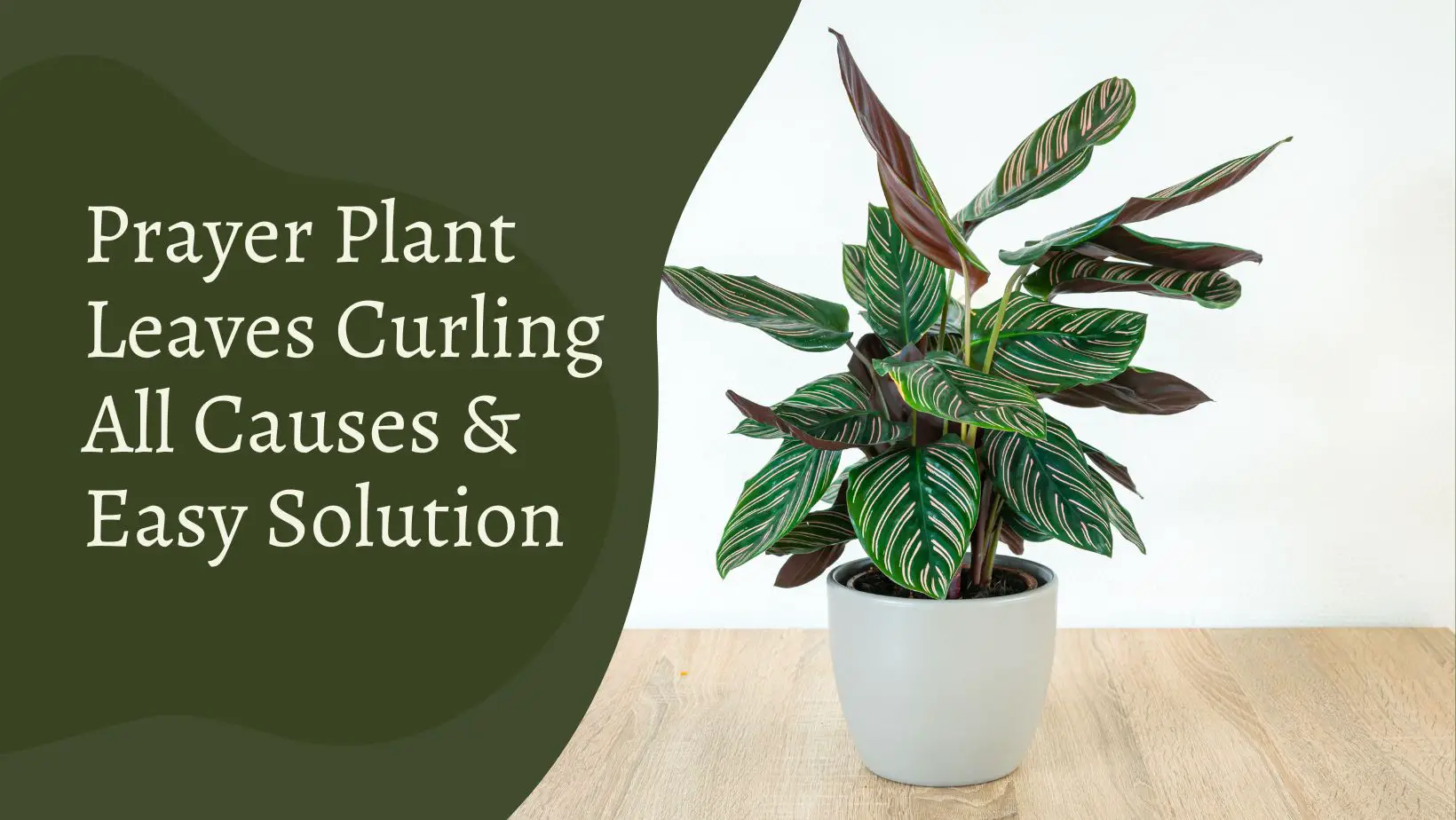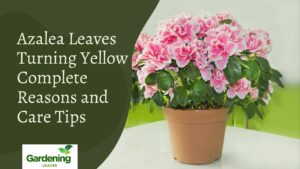
Prayer plant leaves curling can be caused by a variety of factors, but the most frequent include watering, sunshine, and humidity. We can avoid curled leaves and help Marantas thrive in our houses by simulating their native jungle environment. Prayer Plants (Maranta leuconeura) are treasured houseplants with brightly patterned, oval leaves that appear to have been painted.
They are ideal for bringing a dash of color and interest to the house, and they may thrive in low-light situations where other tropical plants might struggle. Marantas, on the other hand, are prone to a variety of issues, including prayer plant leaves curling.
The tropical woods of South America are home to prayer plants. And, when cultivated inside, they have specific requirements that must be followed in order for them to look their best. The leaves of a healthy Prayer Plant will lie flat during the day and fold up and in at night.

The Most Likely Causes of Prayer Plant Leaves Curling:
The measures you’ll take to fix your Prayer Plant’s curled leaves may vary depending on what’s causing the problem. The most prevalent causes of curled leaves on Prayer Plants are listed below. Continue reading to determine the source of your problem before taking steps to resolve it.
Water abuse causes prayer plant leaves curling
When Maranta leaves curl, it’s usually due to a lack of water — either too much or too little. I’ll go through appropriate watering in more detail in the section below but the short version is that Prayer Plants are finicky about how much or how little water they get. Because all of these conditions can lead leaves to curl, it’s important to keep the soil moist but not soggy.
Water quality is another factor that causes leaves to curl
Rainwater is the best option for watering potted plants since it is the closest to what they would get in nature. It also avoids contaminants present in tap water, such as fluoride, chlorine, and salt, which are harmful to plants. These can build up in the soil, causing browning and curling of the leaf tips.
If you can’t collect rainwater, you can use distilled water, aquarium water, or (at the very least) let your tap water rest for a time before using it to let some of the pollutants evaporate. These tips will go a long way toward achieving the brilliant, flat leaves that are so characteristic of Prayer Plants.
Cold exposure cause prayer plant leaves curling
If watering and water quality aren’t a concern, curled Prayer Plant leaves might be the consequence of the plant becoming too cold. Cool temperatures or draughts will cause Marantas to respond.
Marantas dislike being chilly since they are used to living in warm, humid settings. The average interior temperature is ideal, however this plant should be kept away from open windows.
Pest Problems causes prayer plant leaves curling
Leaf curling can be caused by insects that feed on plants. This look in the leaves is most likely caused by those who destroy the plant’s cells by sucking nutrients from the leaf. To rule out aphids, scale, or other pests, carefully inspect your plant. If you locate any, a few applications with neem oil will kill all of these insects.
Humidity or direct light cause prayer plant leaves curling
Finally, prayer plant leaves curling can be caused by a lack of humidity or too much direct sunshine, although this is frequently in conjunction with other, more acute symptoms. Prayer Plants like indirect light and higher-than-average humidity, so you’ll probably observe brown, crispy edges on the leaves and maybe regions of discoloration in these circumstances.
Prayer plant leaves curling and turning brown:
Low humidity, incorrect watering, extra fertilizer, or even too much sun all create brown tips on prayer plants. Cultural conditions are simple to alter, and your lovely houseplant will soon be restored to its former splendor. If you take a close look at where your plant is and how you care for it, you’ll be able to figure out why your prayer plant’s leaves are brown.
Irrigate the container with rainfall or distilled water. Minerals in excess, as well as typical tap water additions, may be straining the plant. From spring through autumn, feed your houseplant every two weeks using a diluted soluble plant food.
Improper dilution or frequent feeding, on the other hand, will result in a build-up of the salts included in fertilizer. This may be flushed out of the soil or, in the worst-case scenario, the plant can be repotted with high-quality houseplant soil.
How to revive a prayer plant:
Here’s how you may assist houseplants suffering from the aforementioned issue in reviving. It all starts with when you first detected symptoms, how you treated them, and what kind of care regimen you followed.
Humidification & Watering
Continue to water on a regular basis to assist maintain or raise relative humidity levels. One way is to pay attention to the watering regimen. Water once every 1–2 weeks, as needed. Second, use room-temperature rainwater to water your prayer plants.
Another acceptable alternative is distilled or chemically filtered water. Tap water contains pollutants such as chlorine, minerals, and other salts, so avoid it. Gardeners may produce a more humid atmosphere by increasing the relative humidity to 40–60 percent.
- Make your Prayer Plants mates with other houseplants for maximum benefit. Plants like the peace lily, maize plant, English ivy, jade plant, spider plant, and miniature date palm should be placed near them.
- Every morning, spritz the leaves with a fine-droplet sprayer. At room temperature, use rain or distilled water.
- Underneath the leaves, place a small water-filled pan with a layer of stones. Leaves should not come into contact with the water in the pan.
- Using a pebble tray to hold your Maranta houseplants. Unless you’re misting, keep the water and the leaves apart from each other.
The prayer plant, like many other tropical plants, can wilt if given too much or too little water. Temperature, light, and humidity levels that are too high or too low can all cause difficulties for the plant. Other factors include nutrition, pests, and illnesses.
Overwatering:
Allow the soil to dry up once you’ve stopped watering it. For a few days, remove the plant from direct sunlight and place it in a shaded location. After that, dig around the roots and inspect them. If root rot is discovered, repot the plant and replace the soil. Then, using room temperature water, water the plant on a regular basis but softly.
Rotten Roots:
Root rot affects most plants with delicate roots, including the prayer plant, which thrives in damp soil. If the soil remains damp for too long, it will succumb to root rot. To check for root rot, carefully dig around the plant’s root perimeter.
Pull the plant up and check the root ball after loosening the dirt. It’s too late to rescue the root ball if more than half of it is injured. Trim the damaged roots and repot the plant in fresh soil if the root rot is restricted.
unsuitable lighting
Because it thrives in the shade of huge trees and bushes, the prayer plant prefers dappled light over direct sunlight. The leaves can be scorched by direct sunshine, and the plant will struggle to thrive under such severe conditions.
Temperatures that are incorrect
The prayer plant is hardy in Zones 11 and 12 for the most part. Even so, you must maintain a constant temperature of 60 to 80 degrees Fahrenheit throughout the year.
Keep the temperature above 60 degrees Fahrenheit. To maintain this temperature range, lay a heat mat under the pot (this one is the correct size and is fairly priced).
Deficiency in Nutrients
Nutrition is another aspect that influences plant development. The prayer plant, as a strong feeder, requires rich, nutritious soil. It also requires a lot of fertilizer all year.
Pests
The plant may be attacked by both spider mites and mealybugs. A white material or brown patches on the leaves are signs of the disease. If the plant is not treated, the foliage will turn brown, leaving it vulnerable to further illnesses.
Disease
The prayer plant droops and wilts due to a variety of ailments. Yellow leaves, brown leaves and stems, blotches on foliage, and dry leaves are all common signs.
Problems with Humidity
Low humidity is one of the most typical reasons why the prayer plant fails to thrive in the house. In most cases, air conditioners and heating equipment dry up the air in our houses.
The plant will droop, and the leaves will curl or fall. Ensure that the humidity level surrounding the prayer plant is at least 80% all year.
Soil Mixture Error
When repotting the plant, always double-check the soil mix you’re using. Using the incorrect potting mix might lead to root issues. Make sure the potting mix has a 2:1:1 ratio of peat moss, loamy soil, and perlite. Make sure the pH of the soil is between 5.5 and 6.
Rootbound:
If you don’t repot the perennial prayer plant on a regular basis, it will get rootbound. The plant will droop and cease developing if the roots get congested and have no place to expand.
Shock After a Transplant
The prayer plant is susceptible to transplant shock when repotting. This frequently occurs when the root ball is exposed to the air for an extended period of time and the roots are allowed to dry.
Prayer plant dropping:
The prayer plant and spider plant care same because of their growing requirements. There might be an issue with the basin soil if the leaves fall. We should replace it with loose, self-contained soil. It’s also possible that incorrect watering and fertilizer are causing the root rot.
Water and fertilizer should be managed, and fertilizer and water should be administered in a reasonable manner. Insufficient sunshine may also contribute to the fall of prayer plant leaves. During the growing stage, it should be put somewhere with enough of light and not too shaded.
Your Prayer Plant Isn’t Getting Enough Water
Prayer plants require a high level of humidity. They’re native to Brazil, where they slither through the forest floor and like damp, warm, and humid circumstances. A lack of humidity is one of the most prevalent causes of a Prayer Plant becoming floppy or drooping.
For those of us who live in the desert or other dry locations where humidity is limited, this may be a major issue. Consider getting a humidifier if you have an abnormally dry house or live in a low-humidity location. Humidifiers are the greatest way to improve the humidity levels around your houseplants, and they come in a variety of sizes, styles, and price ranges.
Read the care Guide of moses plant also! if you have one in your house?
There isn’t enough water in your prayer plant.
A sad droopy Prayer Plant is a dry Prayer Plant. Because they are tropical plants, they demand a consistent level of moisture in the soil. The plant will grow stressed if it is left to dry out too much, and it may droop, wilt, or shrivel. However, there is some good news! Usually, all your plant needs is a brief drink of water to stand tall again.
Water your Prayer Plant well until approximately 25% of the water you put in flows out of the drainage hole in the bottom of the pot when it’s time to water it. However, don’t let it sit in standing water. This will result in damp roots, which will foster root rot, the second most prevalent cause of droopy houseplants.
Your prayer plant is drowning in water.
Strange as it may seem, the exact opposite input can produce the same effect. Overwatering your plants will cause them to droop in the same way that underwatering them will. This occurs as a result of your plant’s root system being damaged by overwatering.
Roots that have been injured are unable to function effectively, which means they are unable to absorb and transfer water to the rest of the plant. The end effect resembles that of underwatering.
Your Prayer Plant Is Experiencing Too Much Sun
When it comes to how much sun they require, prayer plants may be picky. A Maranta should never be in direct sunlight, but should be exposed to strong, indirect light for six or more hours each day, according to the official rule of thumb.
If your Prayer Plant is drooping, wilted, or has brown leaves, check the amount of sunlight it receives. While direct sunlight will not cause your plant to roll up and die, too much or too harsh light will cause it to fade and wilt. The leaves will lose their brilliant patterns and turn brown at the tips if this happens.
Is a prayer plant Calatheas:
Calatheas is a close relative of Maranta leuconeura, which is the true Prayer Plant. There are 31 genera and over 530 species in the Marantaceae plant family.
There are numerous well-known Calathea species that are commonly found as houseplants (and many, many more that aren’t!) in the Calathea genus.
Calathea roseopicta ‘Medallion,’ Calathea roseopicta ‘Medallion,’ Calathea roseopic Calathea makoyana (Peacock Calathea), Calathea lancifolia (Rattlesnake Plant), and Calathea orbifolia (Round-Leaf Calathea) are some of the most popular Calathea cultivars in the United States.
The unique foliage of these plants is highly regarded. Apart from the Calathea and Maranta genera, the Marantaceae family also includes Stroman the and Ctenanthe (Never Never Plant), which are popular houseplants.
These plants, like their siblings, offer brilliant, surprising hues that may give your house a distinct tropical appeal. Because Calatheas and Marantas are closely related and have comparable movement (leaves that move up and down depending on the time of day), it’s simple to see why the moniker Prayer Plant is sometimes misapplied to these group of plants. Maranta leuconeura, on the other hand, has a far more prominent “praying” behavior than other Marantaceae species.
Red prayer plant leaves curling:
Marantas require special attention in order to thrive. They require a constant warm environment as well as bright but indirect light; keep them out of direct sunlight. From spring until fall, keep the soil moist and add some humidity by sprinkling the leaves or standing on a tray of damp stones.
Underwater prayer plant leaves curling:
Marantas that have been underwatered will grow drooping, and their leaves may become brown or even crispy as a result of dehydration. Curling leaves are also possible. These indications can also be found in leaves that have been exposed to low humidity, air conditioning, or too much direct sunlight.
Conclusion:
Curling leaves on a Prayer Plant can be dramatic and scary, especially because this symptom can be caused by a variety of issues. The most common cause of prayer plant leaves curling is a lack of water, but there are a few additional causes.
It’s critical to keep a careful eye on your plant and examine it frequently so that any potential problems may be identified as soon as possible. Maranta leuconeura, like most of our indoor plants, thrives in a regular domestic setting, which is why so many people like growing and collecting plants from this family.
However, some plant owners report problems with Marantas and related species, such as dry, curled leaves. You should be able to determine why the leaves are curling if you have a full grasp of the natural circumstances where Prayer Plants thrive, and then you may take steps to correct the problem. Even if some leaves are lost in the process, Marantas may swiftly regenerate new growth, so don’t give up! With a few minor changes to the environment, you should be able to cultivate a lovely specimen.

Hi This is Maria, We are a team of gardening enthusiasts with a passion for gardening. We have tried to bring you tips and advice enabling you to grow and maintain a healthy and beautiful garden. We Hope You Find it Useful.






